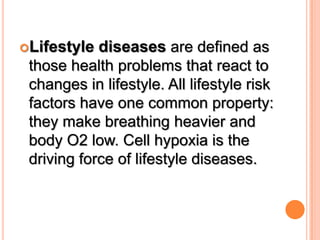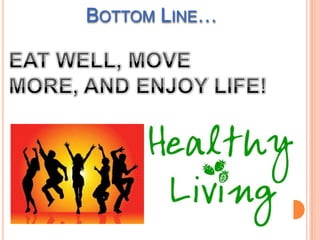lifestyle diseases
- 2. Lifestyle diseases are defined as those health problems that react to changes in lifestyle. All lifestyle risk factors have one common property: they make breathing heavier and body O2 low. Cell hypoxia is the driving force of lifestyle diseases.
- 3. Human Body
- 4. WHAT CAUSES LIFESTYLE DISEASES ? Certain habits, behaviors, and practices such as poor eating habits, inactivity, or smoking. Factors that we cannot control such as age, gender, and heredity.
- 5. PROMINENT RISK FACTORS Disease Risk factors Heart disease Smoking, high BP, elevated Cholesterol, diabetes, Obesity, physical inactivity, Ty-A personality Cancer Smoking, alcohol, solar radiation, ionizing radiation, work-site hazards, environmental pollution, medications, infectious agents, dietary factors Stroke High BP, Elevated cholesterol, smoking Diabetes Obesity, diet RTA Alcohol, no-use of seat belts, speed, roads Cirrhosis Alcohol
- 7. CARDIOVASCULAR DISEASES Your heart and blood vessels make up your cardiovascular system. The diseases that result from damage to your heart and blood vessels are called cardiovascular diseases. Types of CVDs: heart attack, atherosclerosis, and high blood pressure.
- 8. RISK FACTORS Controllable Tobacco Use High Blood Pressure High Cholesterol Sedentary Lifestyle Excessive Weight Stress Drug and Alcohol Use Uncontrollable Heredity Gender Age
- 9. TYPES OF CARDIOVASCULAR DISEASES High Blood Pressure Heart Attack Atherosclerosis
- 11. CANCER Uncontrollable growth of abnormal cells
- 12. CANCER Cancer- a disease caused by uncontrolled cell growth More than one million people in the United States are diagnosed with cancer every year. Cancer is the second leading cause of death Cancer is more common in adults, but teens can get some forms of cancer.
- 13. RISK FACTORS FOR CANCER Tobacco use Sexually Transmitted Diseases Dietary Factors Radiation Asbestos
- 14. CAUTION C – Change in bowel habits A – A sore that does not heal U – Unusual bleeding or discharge T – Thickening or a lump I – Indigestion or difficulty swallowing O – Obvious change in a wart or mole N – Nagging cough or hoarseness
- 16. PRACTICING HEALTHY LIFESTYLES Diet- (Nutrition)Adopt healthy eating patterns, Consume fewer Calories and be physically active. Exercise- (Physical Activity)At least 150 min per week of moderate-intensity, 2 or more days per week of musclestrengthening activities. Relaxation- Work/school/personal life balance, Relaxation response for 20 min, 1-2x/day Addiction Management- Smoking, alcohol, food, drug, sex, violence
- 18. BOTTOM LINE…


















